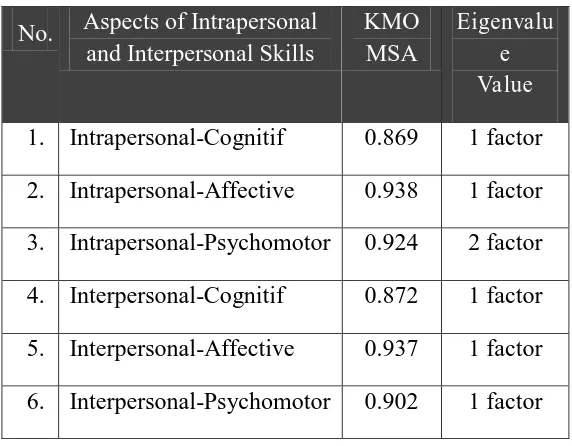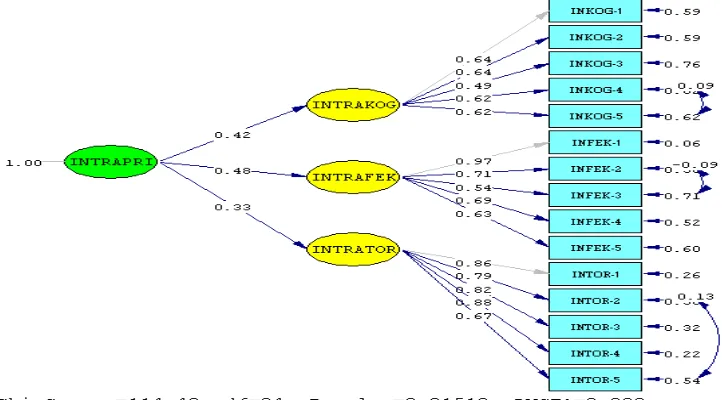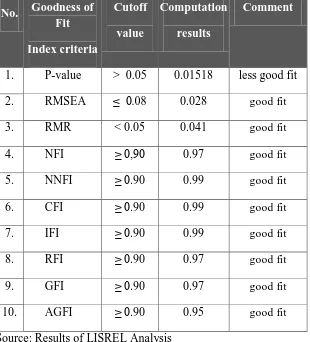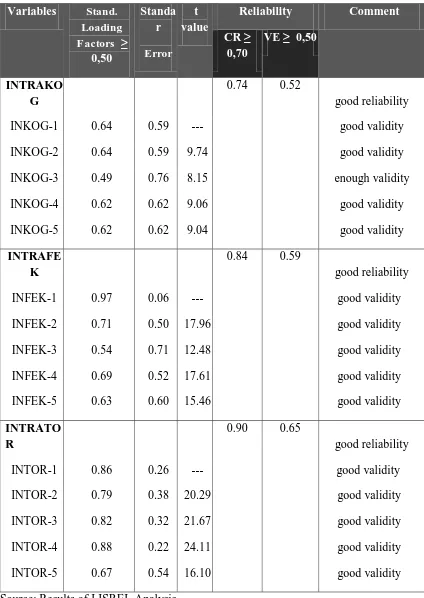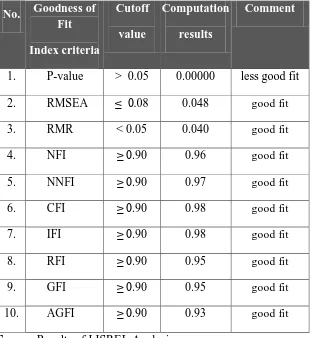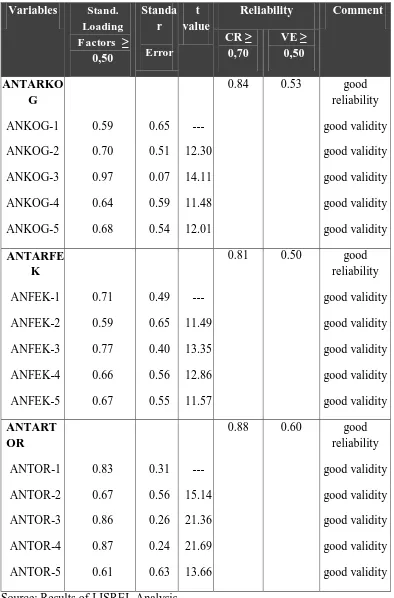THE MEASUREMENT MODEL OF INTRAPERSONAL AND INTERPERSONAL SKILLS CONSTRUCTS
BASED ON CHARACTER EDUCATION IN ELEMENTARY SCHOOLS
Akif Khilmiyah
Muhammadiyah University of Yogyakarta [email protected]
Abstract
The objective of this study is to test the constructs of intrapersonal and interpersonal skills based on character education in elementary school, and to evaluate the validity of indicators, and its constructs reliability. The population of this study were the fifth grade students of the elementary schools in Yogyakarta Special Region, including: Yogyakarta, Sleman, Bantul and Gunungkidul. The sample size was 464 students from 15 elementary schools. The data were collected by using a questionnaire and analyzed by using Explanatory Factor Analysis (EFA) and Confirmatory Factor Analysis (CFA). The results of this study are as follows that the constructs of intrapersonal and interpersonal skills based on character education in elementary schools has fulfilled the criteria of validity, reliability, and goodness of fit statistic. Thus, the construct of intrapersonal and interpersonal skills can be used to develop the assessment model of intrapersonal and interpersonal skills based on character education in elementary school. It can be used to detect the level of achievement of intrapersonal and interpersonal skills of elementary school students.
Keywords: measurement model, intrapersonal skills, interpersonal skills, character education.
Introduction
The purpose of character education in schools is to educate the students become the overall superior personal, namely the smart personal intellectually, emotionally, socially, and spiritually. The planting of this character education should start from the basic education in the elementary school. The building overall superior personal had been stated in pasal 3, UU No. 20/2003 about national education (Kemendiknas, 2011: 243).
The results of survey that was conducted in several elementary schools in Yogyakarta,
it was found that 70% of elementary schools students intelligence that is developed in the elementary schools is the intellectual intelligence through cognitive assessment. The teachers
assessment model that is used by teachers varies and is usually developed by the religious teachers. The most teachers assume that the building students character and morals is done through the religious subjects.
The assessment practice of learning outcomes in elementary schools is conducted by the cognitive assessment. The student appreciation is done by teachers with giving the
students ranking and test scores (Zuchdi, 2010: 68). Although all teachers know that the education have three domains, namely cognitive, affective, and psychomotor, but in practice
the affective and psychomotor assessment haven‘t received the adequate attention. This condition occurs due to a lack of the ability of educators to describe the performance indicators of the affective domain. Thus, teachers assessment haven‘t described the ability of students overall. As a result, teachers aren‘t able to provide the guidance of affective aspects which include the emotional, social, and spiritual intelligences. This affective aspects are manifested in the form of intrapersonal and interpersonal skills. Both of these skills are the core of the character education that need be given to students in the learning process in elementary schools.
The development of intrapersonal and interpersonal skills is very important because both of these skills have the major impact on a person's success in life.
The results of the studies conducted by Goleman (1995: 15), Gardner (1996: 26), and Bar-On (1988: 24; 1997: 123; 2000: 46; 2005: 94), Berkowitz (2002: 23) concluded that 80% of the deciding person's success was the emotional intelligence.
Similarly Zamroni‘s research found that 70% of success in life is not because of intellectual and vocational intelligences, but rather as a generic intelligence (2005: 49). The generic capability is shown through personal abilities and social skills.
The effects of lack of attention to intrapersonal and interpersonal skills in school can cause the existence of various forms of asocial behavior among elementary school students. Based on the research results by Marzuki (2008: 59), that a decline in the moral behavior of students from cultural norms and religious rules is caused by the low intrapersonal and interpersonal skills in students. Every day people felt that the moral values desired hadn‘t still
been suitable. The decline in moral behavior and attitudes of these students was felt at all levels of education, especially at the elementary school level as the foundation of the first
education for children in schools.
Therefore, this study is important and strategic to be done because the measurement model of intrapersonal and intrapersonal skills constructs become the basis for arrangement the assessment model of intrapersonal and interpersonal skills based on character education in elementary school students. Thus, the findings of this study can be used by elementery school teachers to improve students' character embodied in the form of emotional, social, and spiritual intelligences. Besides, this assessment model can be used to determine the performance of intrapersonal and interpersonal skills in order to implement character education in elementary school students, so that teachers can do early the character building the elementary school students.
.
Constructs of Interpersonal and Intrapersonal Skills
Lickona argues that in teaching the good character should involve three aspects of character education, namely: (1) aspect of moral knowing (the knowledge of good
morals), (2) aspect of moral feeling (feel a moral goodness), and (3) aspect of moral action (values moral practiced in life) (1992: 53). In aspect of moral knowing, there are six
things that become purpose of the character education teaching, namely: (1) moral awareness, (2) knowing moral values), (3) perspective taking, (4) moral reasoning, (5) decision making, and (6) self-knowledge.
Manifestations of character education is also associated with intrapersonal and interpersonal skills. Intrapersonal skills are defined as the individual's ability to recognize, appreciate, managing, controlling sense of self, and feel the reality of self-spiritual to understand the reality of self-existence and dare to be responsible for private life, so that forming a noble personality. This definition was formulated as a result of the synthesis of five
theoretical concepts of intrapersonal skills by Gardner (1993: 24-25), Lazear (2000: 24), Bar-On (1997b: 120), Lwin. (2005: 233), and Amin (1974: 61). Meanwhile, interpersonal skills
are defined as the ability to appreciate the views of others, realizing social responsibility, working together, tolerant, and able to communicate with others. This definition as a result of the synthesis of five theoretical concepts of interpersonal skills by Gardner (1993: 240), Bar-On (1997b: 161), Lazear (2000: 23), Mant (1997: 161), and Cunningham & Corderio (2003 : 205).
Based on this conceptual definition can be formulated indicators of intrapersonal and interpersonal skills. Intrapersonal skills has five indicators, namely: (1) recognize self-feeling, (2) respect self-self-feeling, (3) managing self-self-feeling, (4) control self-self-feeling, and (5) feel the reality of self-spirituality. Meanwhile, interpersonal skills has five indicators, namely: (1) respect the views of others, (2) be aware of social responsibility, (3) collaboration with others, (4) tolerance toward others, and (5) communicate effectively with others.
Zuchdi (2010: 51-53) says that to assess the achievement of the objectives of character education, the assessment of intrapersonal and interpersonal skills can be done on three aspects of the character, namely reasoning, feeling, and behavior. Therefore, this study was
conducted to develop a measurement model of intrapersonal and interpersonal skills constructs of elementary school students that covers all three domains, namely cognitive,
affective, and psychomotor.
Method
character education programs in schools. Based on these criteria, sample that was selected included: four elementary schools piloting in character education, two elementary schools non-piloting in character education, one private elementary school patterned nationality, four private elementary schools based on Islamic, two private elementary schools based on Catholic, two elementary schools implementing full day, two public and private ―Madrasah Ibtidaiyah‖.
The data were collected by using a questionnaire and analyzed using the Explanatory
Factor Analysis (EFA) dan the Confirmatory Factor Analysis (CFA). EFA method is used to determine the eigenvalues which are formed to be a factor of the latent variable. Thus, this method is able to show the dimensions of the latent variable that can be used as a factor in the formation of intrapersonal and interpersonal skills constructs in aspects: cognitive, affective, and psychomotor. Meanwhile, CFA method is used to test the criteria of the goodness of fit statistic of the latent variables measurement model, evaluate the indicators validity and the construct reliability of the latent variables (Joreskog and Sorbon, 1999: 115).
Finding and Discussion
[image:5.595.71.357.492.715.2]The results of the construct validity test by using EFA to construct intrapersonal and interpersonal skills of elementary school students are shown in Table 1.
Table 1. Results of Testing EFA
No. Aspects of Intrapersonal and Interpersonal Skills
KMO MSA
Eigenvalu e Value
1. Intrapersonal-Cognitif 0.869 1 factor
2. Intrapersonal-Affective 0.938 1 factor
3. Intrapersonal-Psychomotor 0.924 2 factor
4. Interpersonal-Cognitif 0.872 1 factor
5. Interpersonal-Affective 0.937 1 factor
6. Interpersonal-Psychomotor 0.902 1 factor
and the value of KMO MSA is greater than 0.70. This includes categories satisfying, and formed factor is unidimensional. This indicates that the five aspects of intrapersonal and interpersonal skills constructs of elementary school students in according with the indicators estimated as unidimensional. Meanwhile, the psychomotor aspects of intrapersonal skills are two factors that have eigenvalue greater than 1. Yet the factors are selected only one factor
that have close meaning with the measured variables, and have a variance greater.
This study uses the second order confirmatory factor analysis (CFA). Measurements on
[image:6.595.85.446.297.497.2]the second order CFA shows the relationship between the indicators and the latent variables. The results of testing using the second order CFA for measuring the intrapersonal skill construct is shown in figure 1.
Figure 1. The test results of the intrapersonal skill construct
Table 2. Results of fit test of the intrapersonal skill construct No. Goodness of
Fit
Index criteria
Cutoff
value
Computation
results
Comment
1. P-value > 0.05 0.01518 less good fit
2. RMSEA ≤ 0.08 0.028 good fit
3. RMR < 0.05 0.041 good fit
4. NFI ≥ 0,90 0.97 good fit
5. NNFI ≥ 0.90 0.99 good fit
6. CFI ≥ 0.90 0.99 good fit
7. IFI ≥ 0.90 0.99 good fit
8. RFI ≥ 0.90 0.97 good fit
9. GFI ≥ 0.90 0.97 good fit
10. AGFI ≥ 0.90 0.95 good fit
Source: Results of LISREL Analysis
Based on the statistics values of the model fit test results are obtained 9 GOF measure that indicate the good model fit and one GOF shows the less good model fit. Thus, it can be concluded that the measurement model of intrapersonal skill construct has fulfilled the criteria of the goodness of fit statistic, so that the measurement model of intrapersonal skill construct is expressed as a good measurement model. Therefore, the results of these tests can be categorized as the fit measurement model to measure the intrapersonal skill construct.
The measurement model of intrapersonal skill construct is analysed by using the second order confirmatory factor analysis. There are three latent variables of the intrapersonal skill construct, namely: cognitive, affective, and psychomotor aspects. In the first level, there are three measurements of the latent variables that are measured by 15 indicators, namely: (1) cognitive latent variable is measured by the observed variables (indicators): INKOG-1, INKOG-2, INKOG-3, INKOG-4, INKOG-5, (2) affective latent
observed variables (indicators): INTOR -1, INTOR-2, INTOR-3, INTOR-4, INTOR-5. Meanwhile, the measurement of the second order CFA shows the relationship between the cognitive, affective, psychomotor latent variables and the intrapersonal skill construct. The results of second order CFA for intrapersonal skill construct is shown in Table 3.
Table 3. Result of Second Order CF A of intrapersonal skill construct Variables Stand.
Loading F actors ≥
0,50
Standa r
Error t value
Reliability Comment
CR ≥ 0,70
VE ≥ 0,50
INTRAKO G
0.74 0.52
good reliability
INKOG-1 0.64 0.59 --- good validity
INKOG-2 0.64 0.59 9.74 good validity
INKOG-3 0.49 0.76 8.15 enough validity
INKOG-4 0.62 0.62 9.06 good validity
INKOG-5 0.62 0.62 9.04 good validity
INTRAFE K
0.84 0.59
good reliability
INFEK-1 0.97 0.06 --- good validity
INFEK-2 0.71 0.50 17.96 good validity
INFEK-3 0.54 0.71 12.48 good validity
INFEK-4 0.69 0.52 17.61 good validity
INFEK-5 0.63 0.60 15.46 good validity
INTRATO R
0.90 0.65
good reliability
INTOR-1 0.86 0.26 --- good validity
INTOR-2 0.79 0.38 20.29 good validity
INTOR-3 0.82 0.32 21.67 good validity
INTOR-4 0.88 0.22 24.11 good validity
INTOR-5 0.67 0.54 16.10 good validity
Based on the test results of second order CFA, the intrapersonal skill construct is acquired 14 values observed variables (indicators) that have value t-count greater than 1.96 (the significance level of 0.05 is 1.96) and the coefficient of the standardized loading factor (λ) is greater than 0.50 (λ > 0.50). Thus, it can be stated that the observed variables (indicators) have good validity. Meanwhile, one value of the observable variables (INKOG-3) has value t-count greater than 1.96 (t-count = 8.15), but the coefficient value of standardized loading factor (λ) is smaller than 0.50 (λ = 0.49), so that it can be stated that the observed variable (INKOG-3) has sufficient validity to the cognitive latent variables (INTRAKOG). Thus, It can be concluded that
the fourteenth indicators used to measure the cognitive, affective, and psychomotor on intrapersonal skills have good validity, but one indicator has sufficient validity.
The sequence of the indicators that have major contributions include: (1) the ability of self-conscious (INFEK-1) with λ6 = 0.97; (2) be able to handle stress, and resilient (INTOR-4) with λ14 = 0.88; (3) the ability of sportsmanship (INTOR-1) with λ11 = 0.86; (4) take risks and dare to make their own decisions (INTOR-3) with λ13 = 0.82; (5) work hard, and never give up (INTOR-2) with λ12 = 0.79; (6) confident and persistent (INFEK-2) with λ7 = 0.71; (7) capable of handling weaknesses, have a competitive spirit, and dare express their feelings (INFEK-4) with λ9 = 0.69; (8) honest, and trustworthy (trust) (INTOR-5) with λ15 = 0.67; (9) the ability of reflective thinking (INKOG-1) with λ1 = 0.64; (10) the ability to think critically (INKOG-2) with λ2 = 0.64; (11) is able to feel the presence of God, recognizing the reality of the spiritual, and is able to take lessons every event (INFEK-5) with λ10 = 0.63; (12) creative (INKOG-4) with λ4 = 0.62; and (13) faith and fear of God (INKOG-5) with λ5 = 0.62; (14) to open up, be accountable to yourself and assertive (INFEK-3) with λ8 = 0.54; and (15) to be innovative (INKOG-3) with λ3 = 0.49.
Based on the test results of the second order CFA, three latent variables of the
intrapersonal skill construct are obtained, as follows: (1) cognitive (INTRAKOG) has the good reliability (CR=0.74 and CR ≥ 0.70; VE=0.52 and VE ≥ 0.50); (2) the affective aspect
(INTRAFEK) has the good reliability (CR=0.84 and CR ≥ 0.70; VE=0.59 and VE ≥ 0.50); (3) psychomotor aspect (INTRATOR) has the good reliability (CR=0.90 and CR ≥ 0.70; VE=0.65 and VE ≥ 0.50). Thus, it can be concluded that the reliability of all latent variables measurement model of the construct of intrapersonal skill are good.
Figure 2. The test results of the interpersonal skill construct
The test results of the second order CFA of the interpersonal skill construct produces the goodness of fit index. The results of testing the second order CFA are shown in the
following table 4.
Table 4. Results of fit test of the interpersonal skill construct No. Goodness of
Fit
Index criteria
Cutoff
value
Computation
results
Comment
1. P-value > 0.05 0.00000 less good fit
2. RMSEA ≤ 0.08 0.048 good fit
3. RMR < 0.05 0.040 good fit
4. NFI ≥ 0.90 0.96 good fit
5. NNFI ≥ 0.90 0.97 good fit
6. CFI ≥ 0.90 0.98 good fit
7. IFI ≥ 0.90 0.98 good fit
8. RFI ≥ 0.90 0.95 good fit
9. GFI ≥ 0.90 0.95 good fit
10. AGFI ≥ 0.90 0.93 good fit
[image:10.595.103.415.404.742.2]Based on the statistics values of the model fit test results are obtained 9 GOF measure that indicate the good model fit and one GOF shows the less good model fit. Thus, it can be concluded that the measurement model of interpersonal skill construct has fulfilled the criteria of the goodness of fit statistic, so that the measurement model of interpersonal skill construct is expressed as a good measurement model. Therefore, the results of these tests can be categorized
as the fit measurement model to measure the interpersonal skill construct.
The measurement model of interpersonal skill construct is analysed by using the second
order confirmatory factor analysis. There are three latent variables of the interpersonal skill construct, namely: cognitive, affective, and psychomotor aspects. In the first level, there are three measurements of the latent variables that are measured by 15 indicators, namely: (1) cognitive latent variable is measured by the observed variables (indicators): ANKOG-1, ANKOG-2, ANKOG-3, ANKOG-4, ANKOG-5, (2) affective latent variable is measured by the
observed variables (indicators): ANFEK-1, ANFEK-2, ANFEK-3, ANFEK-4, ANFEK-5, and (3) psychomotor latent variable is measured by the observed variables (indicators): ANTOR-1,
Table 5. Result of Second Order CF A of interpersonal skill construct Variables Stand.
Loading F actors ≥
0,50
Standa r
Error t value
Reliability Comment
CR ≥ 0,70
VE ≥ 0,50
ANTARKO G
0.84 0.53 good
reliability
ANKOG-1 0.59 0.65 --- good validity
ANKOG-2 0.70 0.51 12.30 good validity
ANKOG-3 0.97 0.07 14.11 good validity
ANKOG-4 0.64 0.59 11.48 good validity
ANKOG-5 0.68 0.54 12.01 good validity
ANTARFE K
0.81 0.50 good
reliability
ANFEK-1 0.71 0.49 --- good validity
ANFEK-2 0.59 0.65 11.49 good validity
ANFEK-3 0.77 0.40 13.35 good validity
ANFEK-4 0.66 0.56 12.86 good validity
ANFEK-5 0.67 0.55 11.57 good validity
ANTART OR
0.88 0.60 good
reliability
ANTOR-1 0.83 0.31 --- good validity
ANTOR-2 0.67 0.56 15.14 good validity
ANTOR-3 0.86 0.26 21.36 good validity
ANTOR-4 0.87 0.24 21.69 good validity
ANTOR-5 0.61 0.63 13.66 good validity
Source: Results of LISREL Analysis
validity. Thus, It can be concluded that the all indicators used to measure the cognitive, affective, and psychomotor on interpersonal skill have good validity.
The sequence of the indicators that have major contributions include: (1) understand the benefits of working together (ANKOG-3) with λ3 = 0.97; (2) empathy, tolerance (ANTOR-4) with λ14 = 0.87; (3) harmony, mutual aid (ANTOR-3) with λ13 = 0.86; (4) the ability to be democratic, and fair (ANTOR-1) with λ11 = 0.83; (5) to be cooperative, solidarity, and participatory (ANFEK-3) with λ8 = 0.77; (6) the ability to respect the wishes of others (ANFEK-1) with λ6 = 0.71; (7) give priority to the public interest (ANKOG-2) with λ2 = 0.70; (8) determine appropriate communication (ANKOG-5) with λ5 = 0.68; (9) to be friendly, cheerful, and sociable (ANFEK-5) with λ10 = 0.67; (10) obey the rules, net (ANTOR-2) with λ12 = 0.67; (11) attention to others, be respectful, and tolerant (ANFEK-4) with λ9 = 0.66; (12) know the difficulties of others (ANKOG-4) with λ4 = 0.64; (13) skilled conflict resolution, and friends (ANTOR-5) with λ15 = 0.61; (14) the ability to understand the thoughts and feelings of others (ANKOG-1) with λ1 = 0.59; and (15) care for the environment, feel partly responsible, self-sacrificing, and helpful (ANFEK-2) with λ7 = 0.59.
Based on the test results of the second order CFA, three latent variables of the interpersonal skill construct are obtained, as follows: (1) cognitive has the good reliability (CR=0.84 and CR ≥ 0.70; VE=0.53 and VE ≥ 0.50); (2) the affective aspect has the good reliability (CR=0.81 and CR ≥ 0.70; VE=0.50 and VE ≥ 0.50); (3) psychomotor aspect has the good reliability (CR=0.88 and CR ≥ 0.70; VE=0.60 and VE ≥ 0.50). Thus, it can be concluded that the reliability of all latent variables measurement model of the construct of interpersonal skill are good.
Based on the test results of the second order CFA, it can be seen that two models,
namely: (1) the measurement model of intrapersonal skill construct (INTRAPRI) consisting of intrapersonal-cognitive skill aspects (INTRAKOG), intrapersonal-affective skill aspects (INTRAFEK), intrapersonal-psychomotor skill aspects (INTRATOR), and (2) the measurement model of interpersonal skill construct (ANTARPRI) consisting of interpersonal-cognitive skill aspects (ANTARKOG), interpersonal-affective skill aspects (ANTARFEK), interpersonal-psychomotor skill aspects (ANTARTOR) have fulfilled the statistical requirements and are categorized as the fit measurement model. This means that both the measurement model have fulfilled the goodness of fit statistic, so that it can be used as an instrument to detect the intrapersonal and interpersonal skills achievement in character education in the elementary schools.
items are the eflective thinking skill, and the critical thinking skill, meanwhile the smallest item is innovative; (2) intrapersonal-affective skill aspect, the biggest item is self-aware capability, meanwhile the smallest item is open, accountable to yourself and assertive; (3) intrapersonal-psychomotor skill aspect, the biggest item is able to handle stress, and tough, meanwhile the smallest item is honest, and trustworthy (trust); (4) interpersonal-cognitive
skill aspect, the biggest item is to understand the benefits of cooperation, meanwhile the smallest item is the ability to understand the thoughts and feelings of others; (5)
interpersonal-affective skill aspect, the biggest item is to be cooperative, solidarity, and participatory, meanwhile the smallest item is concerned with the environment, to feel partly responsible, self-sacrificing, and helpful; and (6) interpersonal-psychomotor skill aspect, the biggest item is empathetic, tolerant, meanwhile the smallest item is skillfully resolve conflicts, and friends.
Conclusion and Suggestion
The conclusions of this study can be formulated that the measurement models of intrapersonal and intrapersonal skills constructs at the elementary school students are declared valid and reliable because all the indicators that are used to measure the cognitive, affective, and psychomotor skills in intrapersonal and interpersonal constructs have the loading factor coefficient values greater than 0.50. Meanwhile, the reliability of the intrapersonal and interpersonal skills construct have a composite reliability coefficient (construct reliability) greater than 0.70. This measurement model of constructs also fulfills the criteria in goodness of fit statistics, so that the measurement model of intrapersonal and
intrapersonal skills constructs at elementary school students are declared a measurement model that has fulfilled the criteria for a valid, reliable, and goodness of fit statistic. Thus, the
results of this study can be developed to create the assessment model of intrapersonal and interpersonal skills based on character education in the elementary school.
References
Amin, A. (1974). Kitab al-akhlak. Beirut-Lubnan: Dar al-Kitab al-‗Araby.
Bar-On, R. (1988). The development of a concept of psychological well-being. Doctoral dissertation: Rhodes University, South Africa.
_________. (1997a). The emotional quotient inventory (EQ-i): a test of emotional intelligence. Toronto, Canada: Multi-Helth Systems, Inc.
_________. (1997b). The emotional quotient inventory (EQ-i): technical manual. Toronto. Canada: Multi-Health Systems, Inc.
_________. (2000). Emotional dan social intelligence: Insights from the emotional quotient inventory (EQ-i). In R.Bar-On and J.D.A.Parker (Eds), Handbook of emotional intelligence. San Francisco: Jossey-Bass.
_________. (2005). Emotional intelligence and subjective wellbeing. Manuscript submitted for publication.
Bar-On, R., & Fund, S. (2004). The impact of emotional and social intelligence on self-preceived physical helth. Manuscript submitted for publication.
Berkowitz, M.W., Battistich, V.C., & Bier, M.C. (2002). What works in character education: What is known and what needs to be known. In Nucci, Larry P.& Narvaez, Darcia. (Eds.). Handbook of moral and chara cter education pp.414-431. New York and London: Routledge Taylon & Francis Group.
Cunningham, W.G., & Paula, A.C. (2003). Educational leadership: a problem based approach. Boston: Pearson Education.
Gardner, H. (1993). Frames of mind: the theory of multiple intelligence. New York: Basic Books.
__________. (1996). Intelligence: multiple perspectives. Harcourt Brace College. Fort Worth. Tex.
Goleman, D. (1995). Emotional intelligence, why it can matter more than IQ. New York: Bantam Books.
Joreskog, K.G., & Sorbom, D. (1999). Lisrel 8: User‟s reference guide. Chicago: Scientific Software International.
Ministry of Education. (2011) The guidance of implementation of character education. Jakarta: Research and Development Department of Education.
Khilmiyah, A. (2011). Evaluation of the implementation based on character education in elementary schools of piloting character education in the district of Bantul. Research Report. Yogyakarta: LP3M UMY.
__________ (2012). Comparison of intrapersonal and interpersonal skills of state elementary school students in Kasihan Bantul. Afkaruna Journal, vol.8 No. 2 July - December 2012. ISSN 1693-4040. Yogyakarta: FAI UMY.
Lwin, M. (2005). How to multiply your child‟s intelligence. Terjemahan Christine S. Jakarta: Indeks.
Mant, A. (1997). Intelligent leadership. New South Wales: Allen & Unwin.
Plomp, T.J. (1997). Educational design: introduction. from Plomp (eds.). Educational & training system design: introduction. Design of education and training (in Dutch). Utrecht (the Netherlands): Lemma. Netherland. Faculty of Educational Science and Technology, University of Twente.
Wijanto, Setyo Hari. (2008). Structural equation modeling with Lisrel 8.8 concepts and tutorials. Yogyakarta: Graha Ilmu.
Zamroni. (2005). Development of the educational assessment system that implements the CBC under an autonomy. Journal of Educational Research and Evaluation. Vol 2. No. 12, May 2005, Year 11, ISSN 1410-4725. Yogyakarta: HEPI PPs. UNY.
Zuchdi, D. (2010). Humanization of education, rediscover the humane education. Jakarta: Bumi Aksara.
